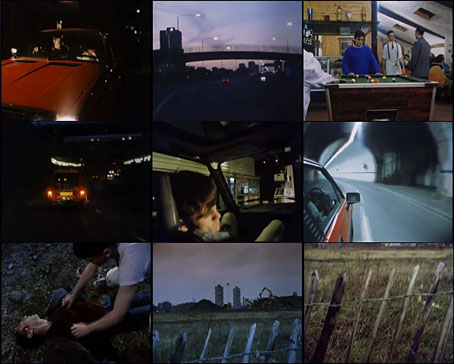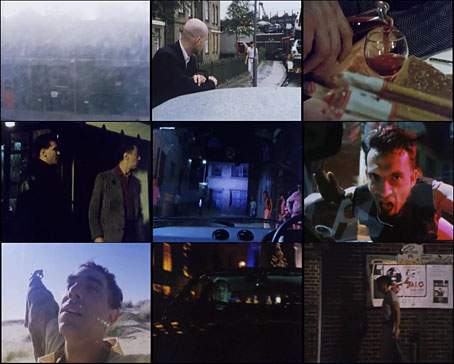One of Derek Jarman’s many unfilmed projects was PPP in the Garden of Earthly Delights, a study of the last days in the life of director Pier Paolo Pasolini seen through a prism of references to the director’s cinematic work, and also the paintings of Hieronymus Bosch. Jarman’s proposal exists as a synopsis rather than a screenplay, presenting a series of isolated scenes: the film set for the final scene from Salò, or the 120 Days of Sodom (1975); an expensive restaurant; a street at night where Pasolini is cruising for sex; a cheap restaurant; a petrol station; an area of waste ground where Pasolini is killed by the rent boy he’s picked up. The foreground events parallel moments from Pasolini’s life and death, while the background would have featured characters from his earlier films, and various Boschian figures or motifs. The synopsis was printed in the Derek Jarman issue of Afterimage in autumn 1985, and it’s likely that the outline contributed to Julian Cole’s film, Ostia, which was made as a final-year student project a year later.
Ostia is unusual for being a film in which Derek Jarman is the lead actor, although when you see his acting it’s not so surprising that he kept himself out of his own films; Cole says on a commentary track for Ostia that some of Jarman’s performance was so bad it had to be cut. There is the curiosity value of seeing him playing the part of Pasolini, something that Jarman suggested when they were discussing the film.
The title refers to the name of the Tyrrhenian resort near Rome where Pasolini was murdered in November 1975, and the narrative favours the theory that Pasolini wasn’t so much murdered as assassinated by an establishment for whom he was a continual thorn in the side. The unforgettable Salò uses De Sade as a frame to explore the worst period of Italian Fascist brutality at the end of the Second World War. Many of those who were complicit in wartime atrocities were still active in Italian society in 1975, and even without the film’s other excesses they wouldn’t have been impressed by Pasolini’s dwelling on the crimes committed during the period of the Salò Republic, or his allusion to the Marzabotto massacre. Pasolini was also a vocal Marxist, of course (Jarman’s synopsis throws some barbs at this), and heavily critical of the deleterious effects of consumerism on post-war Italian society. The assassination theory carries some weight, in other words, even if the face-value explanation—a rough-trade assignation gone awry—seems just as likely. Philo Bregstein’s documentary, Whoever Says the Truth Shall Die (1981) explores the theory in a roundabout fashion, while Ostia (The Death of Pasolini) (1986) by Coil looks at the tragedy through a symbolic lens. “Kill to keep the world turning.”
Julian Cole was working with a micro-budget so beyond the token presence of an Alfa Romeo like the one Pasolini drove (and which was driven over him on the beach) there’s no attempt at verisimilitude. All the scenes are shot in London locations circa 1986, and the dour skies of the metropolis are no match for the perfect blue of Italy. Cole’s film can’t help but be less ambitious than Jarman’s project but at least it got made. Viewed today Ostia has an unavoidable melancholy quality; Cole says that Jarman had just been diagnosed with HIV when they were making the film, and he refused to kiss actor David Dipnall because of this; at the time little was known about the infectiousness of the illness. Dipnall himself, in an unrelated chain of circumstances, died of AIDS a few years later. Ostia is also a reminder of how Pasolini’s death has gained a martyr-like quality among a certain group of gay men, making it a kind of cinematic equivalent to the martyrdom of Oscar Wilde 70 years earlier. It can be seen as an extra on the BFI’s Derek DVD or watched here.

Twenty years ago yesterday, Derek Jarman succumbed to AIDS. Around the time that he was first diagnosed of the illness, in 1986, Jarman starred in a student film by Julian Cole about the last days of Pier Paolo Pasolini. Pasolini, was one of the few homosexual cinema icons Jarman could look to for inspiration, his grotesque murder in Rome in 1975 was a blow for film lovers all over the world.
In 1985 Jarman published a movie treatment, never realized, with the title P.P.P. in the Garden of Earthly Delights that spanned Pasolini’s life from the shooting of the final scene of Salò, or The 120 Days of Sodom through to his death. (Reminiscent of Jarman’s Caravaggio, the treatment apparently drew in the works of Hieronymus Bosch too.) The extent to which that treatment influenced the development of Ostia, Julian Cole’s 25-minute homage to Pasolini (named after the site of his death), is not entirely clear, but the fact is that Jarman agreed to appear in the movie as Pasolini. (According to John Houghton, Cole found Jarman’s acting to be at times so atrocious that it was a considerable challenge to edit around it. Oh, well.)
In the final volume of the director’s journals, Kicking the Pricks, Jarman relates the following reminiscence:
Last year Julian Cole asked me to play Pasolini in his graduate film Ostia. Getting murdered and buried in freezing mud at 4 am as an uncertain sun came up was gruelling, but there was compensation in a trip to Camber Sands where we filmed a desert sequence in the dunes. I took my Super 8 with me and one shot from that day, my shadow racing across the sand, ended up in The Last Of England.
London and the coastal stretch of Camber Sands were never going to pass comfortably for Rome, but to my eye Cole did a pretty good job pulling off the switcheroo. (The spiffy Alfa Romeo helps.) Ostia is purest experimental moviemaking of the mid-1980s, which means it ain’t the easiest thing to follow, but the final chunk depicting Pasolini’s death can’t help but be profoundly affecting.
Jim Ellis comments in Derek Jarman’s Angelic Conversations:
As Jarman’s words [meaning the P.P.P. treatment] indicate, there are profound sympathies between the directors that go beyond the biographical similarities, and indeed, it’s difficult to name a film by Jarman that does not contain some echo of Pasolini, from Sebastiane, where Jarman comes closest to emulating Pasolini, to Blue, which calls to mind the all-blue painting made by the son in Teorema, after a homosexual affair has stripped away his bourgeois pretensions.
If you’ve seen any of Jarman’s movies, you won’t be surprised to learn that Ostia is also strictly NSFW. - dangerousminds.net/


Nema komentara:
Objavi komentar